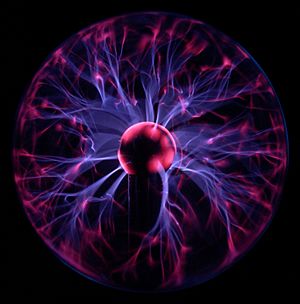Plasma (physics) facts for kids
Plasma is often called the fourth state of matter. It's a lot like a gas, but with a big difference: its tiny particles are electrically charged. Imagine a gas that's been heated so much that some of its electrons break free from their atoms. This creates a mix of free electrons (which are negatively charged) and atoms that have lost electrons (which are now positively charged ions). This special mix is what we call plasma.


Unlike regular gases, the charged particles in plasma react strongly to electric and magnetic fields. This means you can control plasma using these fields, which is something you can't do with a normal gas. If plasma cools down, the electrons and ions will rejoin, turning back into a gas and releasing the energy that made them plasma in the first place.
Contents
Where is Plasma Found?
Plasma is incredibly common in the visible universe. Scientists believe that over 99% of all the matter we can see is actually plasma!
Plasma in Space
Most stars, including our own Sun, are made almost entirely of plasma. Inside stars, plasma is super hot and under immense pressure. But plasma can also exist in very low-pressure places, like in outer space between the stars.
Plasma on Earth
On Earth, you can see natural plasma during a lightning storm. Lightning bolts are streaks of plasma.
How Do We Use Plasma?
Humans have found many ways to use plasma in everyday life and in advanced technology.
Everyday Plasma Uses
- Fluorescent lights: The glowing light inside fluorescent lightbulbs is plasma.
- Neon signs: The bright colors of neon signs come from different gases turning into plasma.
- Plasma screens: Older plasma displays used for televisions or computer screens also use tiny cells of plasma to create images.
- Plasma lamps: These are popular toys and decorations that show how plasma reacts to electric fields.
Future Plasma Technology
Scientists are working on exciting new ways to use plasma. One major area is nuclear fusion. This is a type of nuclear power that tries to copy how the Sun makes energy. It involves heating plasma to extreme temperatures so that atomic nuclei can combine, releasing huge amounts of energy. If successful, fusion power would be much safer than current nuclear power plants and produce very little radioactive waste.
Related pages
Images for kids
-
Artist's rendition of the Earth's plasma fountain, showing oxygen, helium, and hydrogen ions that gush into space from regions near the Earth's poles. The faint yellow area shown above the north pole represents gas lost from Earth into space; the green area is the aurora borealis, where plasma energy pours back into the atmosphere.
-
Artificial plasma produced in air by a Jacob's Ladder
-
Hall effect thruster. The electric field in a plasma double layer is so effective at accelerating ions that electric fields are used in ion drives.
See also
 In Spanish: Plasma (estado de la materia) para niños
In Spanish: Plasma (estado de la materia) para niños







